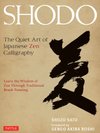Shodo: The Quiet Art of Japanese Zen Calligraphy, Learn the Wisdom of Zen Through Traditional Brush Painting
amazon.com
Saved by Lael Johnson and
Shodo: The Quiet Art of Japanese Zen Calligraphy, Learn the Wisdom of Zen Through Traditional Brush Painting

Saved by Lael Johnson and
for the artist of shodo—whether in China, Japan or Korea—the traditional style of kanji is still used.
katakana is reserved solely for writing foreign words.
meaning. A major distinction between the kanji writing system and an alphabet-based writing system is that a single ideogram of kanji is a “word” carrying a specific meaning.
However, in order to work in the sosho style, it is necessary to first master the order of the strokes in both the kaisho and gyosho styles. Without a firm knowledge of these requirements, the purpose and effect of the highly simplified sosho lines will not be executed by the calligrapher, and the all-important visual improvisation in personal
... See moreIn the art of sho, spirituality and physical activities have to coincide, therefore breathing control is of utmost importance.
All these arts focus on stripping away unnecessary elements, retaining only what is salient and fundamental.
change in the order of strokes is acceptable, as is adjusting brush strokes to suit one’s own style, and for artistic creativity. This flexibility in gyosho allows the shodo artist the opportunity to produce remarkable works. For this reason also, most Japanese calligraphy is done in gyosho, including bokuseki writings by Zen priests.
The warriors and rich merchants who were retired gave rise to a class of the populace called the "literati" or bunjin (bun=literature; jin=person). This class was well versed in reading and
The creative process in shodo, as in many other arts, is in many ways a “spiritual purification” of the creator.